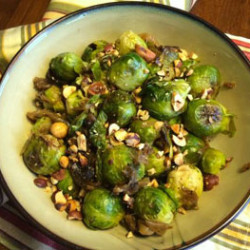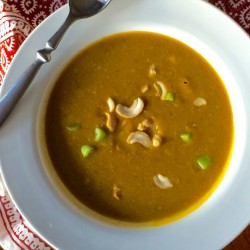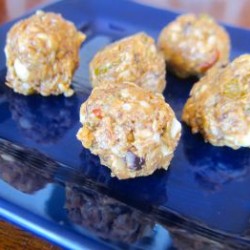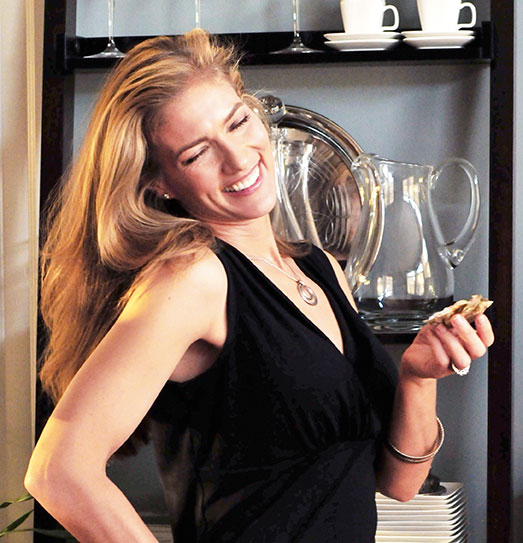Wednesday, October 1, 2014
Have you ever eaten kale, the headless crucifer? If you haven’t (or if you have and hated it), I beg you to keep reading, because I’ve had nothing short of a revelation and I’m down-right giddy about sharing it with you. Following is my kale tale.
Kale and Brussels Sprouts Salad: Who Knew?
It was an article in Bon Appétit by Molly Wizenberg that really got me thinking more seriously about this hearty vegetable. Kale never appeared on the family dinner table when I was a child, and my culinary endeavors as an adult were limited to soups, braising, and sautéing. Cooking seemed important to tame some of the bitterness that kale can have; the thought of eating kale raw had simply never occurred to me. Yes, me. The Nutrition Doctor.
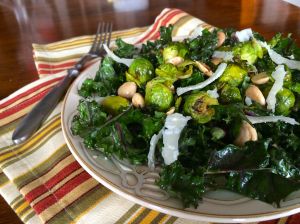
Kale and Brussels sprouts salad, day 1: marcona almonds and pecorino cheese.
Well, you can imagine my skepticism when I stumbled across a recipe for kale and Brussels sprouts salad. Cooked kale was one thing, sure. But raw (I scoffed)? Who could possibly like that? Yet, glancing at the gargantuan head of kale I had just purchased from the farmers’ market, I quashed my negativity and decided to give it a shot. The dish did call for Brussels sprouts, almonds, pecorino, and a lively mustard vinaigrette, after all. How bad could it be?
And if you’re into health, kale is among the most nutritious veggies out there. I’ll bet you already knew that given its prominence as the “it” vegetable for the past several years (though cauliflower has given it a run for its money in 2014). For the record, the sensationalism of “super foods” is pretty silly: most nutrition scientists like me encourage consuming a wide variety of deeply colored vegetables to get a diverse array of nutrients rather than overdosing on just one thing. Keeps your plate more interesting, too; no need for a three-course meal featuring kale and only kale.
Anyway, kale (like Brussels sprouts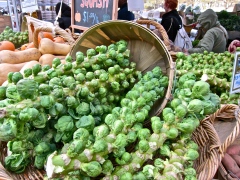 , cauliflower, broccoli, and so forth) is a cruciferous vegetable that has been associated with lowered blood cholesterol and decreased risk of some cancers. These effects are due in part to vitamins A, C, and K and minerals manganese and copper as well as bioactive components like flavonoids and glucosinolates that have an antioxidant and anti-inflammatory effect on the body. Kale is also a reasonable source of calcium, important for you non-dairy drinking folks. The nuts and olive oil in the salad are great sources of healthy monounsaturated fats; almonds are a rich source of many minerals, vitamin E, and fiber and nuts in general have been shown to lower cholesterol and risk of heart disease.
, cauliflower, broccoli, and so forth) is a cruciferous vegetable that has been associated with lowered blood cholesterol and decreased risk of some cancers. These effects are due in part to vitamins A, C, and K and minerals manganese and copper as well as bioactive components like flavonoids and glucosinolates that have an antioxidant and anti-inflammatory effect on the body. Kale is also a reasonable source of calcium, important for you non-dairy drinking folks. The nuts and olive oil in the salad are great sources of healthy monounsaturated fats; almonds are a rich source of many minerals, vitamin E, and fiber and nuts in general have been shown to lower cholesterol and risk of heart disease.
Let’s face it: this salad is nothing short of a nutritional powerhouse.
As importantly, the bitterness of the kale coupled with the caramelized sweetness of the Brussels sprouts alongside the crunch of the almonds and the zing of the Dijon dressing creates a veritable party on the palate. The salad perfectly demonstrates the Healthy Hedonism philosophy that is Cooking and Eating the P.K. Way. I’m not saying it’s pumpkin whoopie pies with maple buttercream or anything—come on, that’s just sheer hedonism and I love it. But as far as salad goes, it rocked my world.
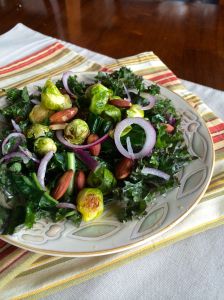
Kale and Brussels sprouts salad, day 2: roasted almonds, red onions, and cheese-free.
In fact, I ditched using the kale in a soup as planned and made it three times. In a row. I swapped caramelized Brussels sprouts for raw grated, since I love them and had some in the fridge. I also happen to think it looks prettier and provides a better contrast of textures and flavors. I’ll probably start getting creative by adding legumes or other proteins—garbanzos? white beans? grilled tofu? salmon?—to turn it into a stand-alone “big salad” main course. And, for the record, I’ve made the salad with and without cheese (right) and it’s great either way, so go ahead and go vegan on this one if you’re into that kind of thing, or if you just want to shave calories.
So that’s how I fell in love with raw kale. Something I never really considered much during the first several decades of my life has now become a go-to salad ingredient following inspiration from my local farmers’ market—there are many varieties of kale to enjoy—and a little encouragement from Bon Appétit. My story reminds us yet again of the importance of always being open to new things: new vegetables, new dishes, new salads, new spices, new ways of cooking and eating. Welcome all of it, and embrace it fully. And I hope I will continue to be of assistance and inspiration to you on your delicious journey towards better health.
After all, we’re in it together: you, me, and our new BFF, kale.
* * *
This article was written today in honor of National Kale Day, which apparently is a thing. It was excerpted from the original post and edited following its original publication on my blog in 2011. For many more kale-inspired recipes, salads, soups, and beyond, please visit my recipe page.

